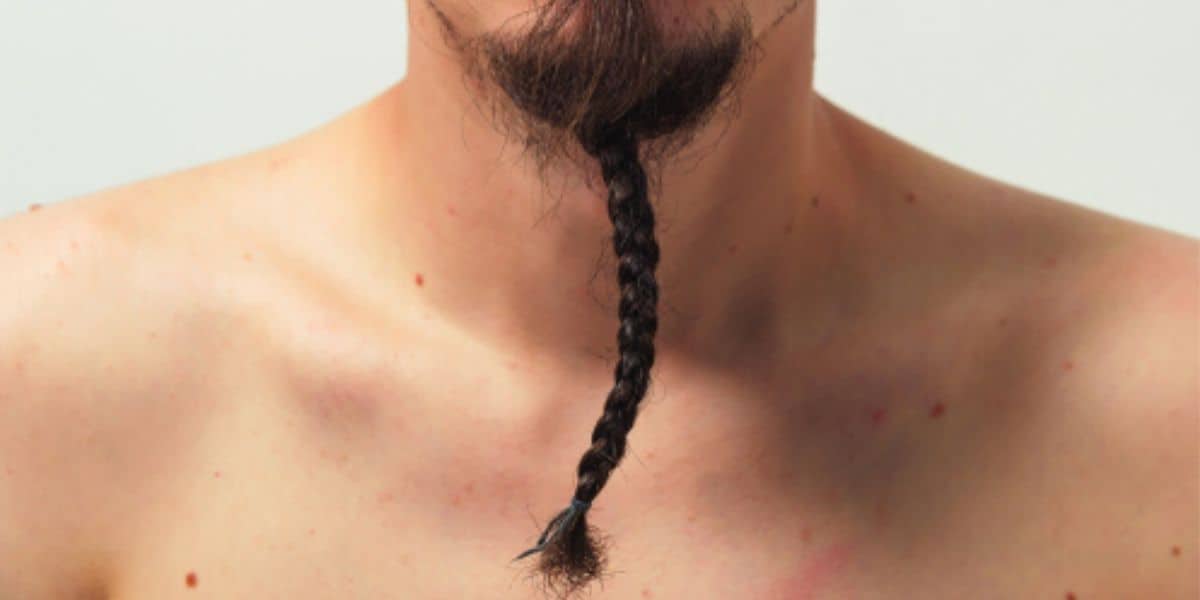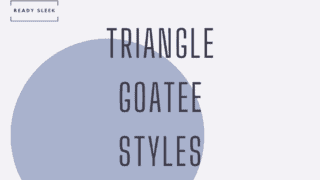The goatee is a pillar of facial hairstyles. It has been for decades and hasn’t shown any signs of slowing down. This article will teach you everything you need to know about the goatee without sides. A style that’s about as classic as it gets.
Its simplicity and versatility have made it a truly global presence. Other key attributes of this style are its ability to elongate and add depth to the chin, as well as how useful it is for patchy-cheeked men.
It’s been adorned by celebs worldwide recently; actors, athletes, musicians, and more. Honestly, sometimes it seems as though a goatee is a prerequisite for Hollywood these days.
There’s more to it than may initially meet the eye. Anyone can grow a goatee – this is a fact. But it’s not enough to just set it, forget it, and perhaps come back to it once it’s convenient. A goatee without sides does require maintenance over the long term.
In this article, I’m going to go through some examples of awesome goatees without sides.
The definition is broad, which is great because you’ve got plenty of options to choose from and experiment with.
I’ll then go through a comprehensive, yet succinct and easy-to-follow, step-by-step routine on how to trim this glorious style by yourself.
Let’s get to work.
4 Great Examples Of Goatees Without Sides
Put simply, a “goatee” is any style that consists of hair on the chin but not on the cheeks. It may or may not include a mustache, and the hair on the chin and mustache may or may not connect.
That’s a definition that is widely recognized but is slightly oversimplifying the matter. This is because there are goatee styles in which there is some hair on the cheeks (sides), albeit not very much.
There is so little hair in comparison with the chin and mustache areas that the overall style can be considered a “goatee”. The goatee with stubble is a good example of this.
The examples you’ll see in this list are essentially of goatees – hair on the chin and potentially the mustache – with no sides at all. In other words, no cheek hair whatsoever.
1. The Full Goatee With No Sides
The Full Goatee is the style that enters most people’s minds when they hear the term “goatee”. To cut a long story short, it consists of a mustache and chin beard connected to each other and encircling the mouth.
There is no cheek hair – this is swiftly and efficiently trimmed down and shaved off.
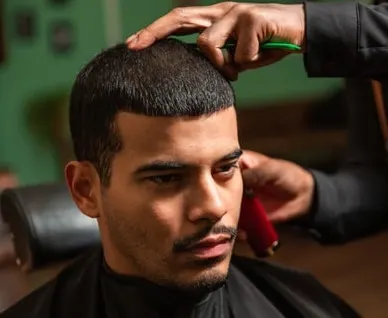
It’s great because of how easy it is to maintain. Although the goatee borders and neckline need shaping up, you generally won’t be spending hours trying to achieve and perfect this look.
That’s what the tutorial at the end of this article is looking to do – teach you how to achieve this failsafe, vintage style with no trouble.
2. The Van Dyke
The Van Dyke should always be considered a variant of a goatee. Check out this full, in-depth discussion on The Van Dyke vs Goatee if you’re interested.
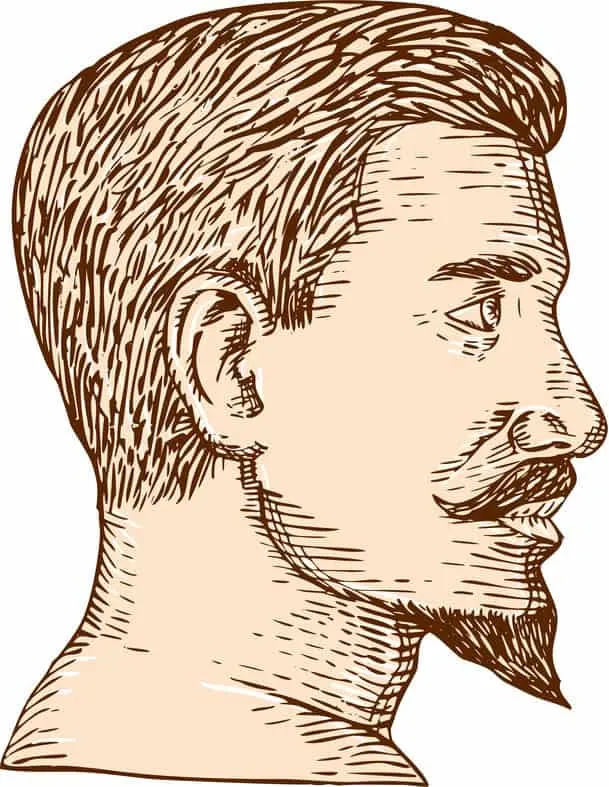
Essentially, it’s a disconnected goatee style – the mustache and chin beard do not connect.
But to go a step further, the mustache is usually styled into a handlebar. To do this, the edges are styled upward, usually with the aid of some trusty mustache balm or wax.
The chin beard is also usually styled into a pointier shape. A downward-facing triangle is a favorite, although this can certainly vary.
Importantly, there is usually no hair on the sides. If there ever is any, it’s usually very thin or short.
It isn’t the quickest style to groom, due to the slightly increased trimming complexity and usual need for additional products. However, it’s a great way to turn some heads if you’re ever bored of the more traditional goatee styles.
3. The Pencil Goatee Without Sides
I do love the name of this style. It’s exactly what you’d expect – a goatee style where the outline is pencil-thin. In other words, it looks like it’s been drawn on with a pencil. Plus, there is usually no hair on the sides.
Its subtlety is what makes it works so well. However, achieving this subtlety is by no means easy. The style does require some fine trimming – the sharper the borders, the more impressive the effect.
For the best results, it’s often necessary to sculpt the outline with a straight razor at the end. This is how those sharp cuts are really tuned in.
It’s a thoroughly modern variant of the goatee that’s a favorite among celebs.
4. The Goatee With No Sideburns
The goatee without sideburns may not fit snugly into this list like the rest of them. But it certainly deserves a mention – technically, it’s a “no hair on the sides” style. It just takes it one step further.
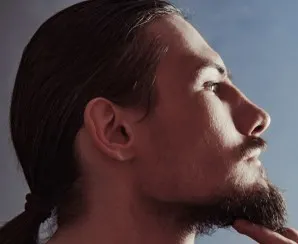
Removing the sideburns is a look that works well with goatees. This is particularly the case with “extended goatees”, where the bottom edges of the goatee tail backward partially along the length of the jawline.
But even with regular Full Goatees, for instance, the no sideburns look does a touch of sophistication.
Ideally, you shouldn’t go overboard with it. Completely removing the sideburns does usually look quite odd. Leave a remnant of the sideburns behind, as they tend to nicely frame the face and the goatee in any case.
How To Trim A Full Goatee Without Sides
This is a step-by-step tutorial teaching you how to trim a Full Goatee with no sides. Remember, a Full Goatee consists of a chin beard and mustache
1. Trim all of the beard down
Before you chisel a solid goatee outline you’ll want to make sure it’s prepared. To do this, simply trim all of your facial hair down to an even length. This should be the length you’ll ultimately want your Full Goatee to be.
It doesn’t matter what distribution or length of facial hair you’ve got right now. You may have a full beard, an existing goatee that needs discipline, or something else.
It doesn’t matter.
Trim everything down to goatee length. Yes, this includes hair that will eventually be shaved off, such as that on the cheeks and neck. It might sound odd, but a goatee outline is much easier to carve out when all of the existing hair is an even length.
To do this you’ll need a pair of clippers or a trimmer. It doesn’t matter what you use. If you’re looking for a good trimmer you can check out the Philips Norelco Oneblade QP6520/70 on
Bear in mind it’ll limit you to length options between 0.4mm and 10mm. For most goatee enthusiasts this is perfectly fine.
2. Trim the outline of the Full Goatee
The hallmarks of a good goatee without sides are as follows:
- Not too narrow
- Sharply defined borders
- Smooth cheeks
- No neck stubble
Let’s start ticking these off, one by one.
To ensure that a goatee isn’t too narrow, allow the sides to follow a natural curve downward as opposed to making them vertical.

It isn’t as intuitive as you may initially think. From a front-on view, goatees may appear as though the sides should be vertical. But actively making them vertical always leads to a narrow-looking goatee.
The best way to avoid making this error is to allow the goatee sides to follow the curve of the mustache downward on either side. In a way, it’s almost like the goatee sides are simply an extension of the mustache.
Once you’ve visualized these lines, trim them using the naked blade of your clipper or trimmer. If your device comes with a T-outliner, this would be ideal. But if not, not a problem. Just use the naked blade (i.e with no attachments or guard combs).
Once you’ve trimmed the outline of your goatee sides, trim all of the hair that lies outside them on the cheeks. Yep – it’s time to remove hair from the sides.
At this point, decide how short you want the sideburns. It’s perfectly reasonable to want them very short when you’re rocking a goatee, as we established earlier. However, do at least leave a stump of a sideburn left to avoid looking like it was an accident.
Also decide what you’ll want to do with your soul patch at this point. The soul patch is the little patch of hair immediately below the upper lip. The goatee with soul patch is a great style to go for. However, the goatee without soul patch also has its benefits.
At the very least, trim the stray hairs either side of and immediately beneath the soul patch to keep the overall goatee looking neat.
At this point, your facial hair should be looking quite a lot like a goatee, but it’s important to shift your attention to the neck at this point.
3. Trim your neckline
“Neck stubble must go” is a saying that shouldn’t really ever be up for debate. There is no excuse for having scraggly neck hairs crawling toward your chest hair. It’s never a good look.
When you’ve got a goatee, it’s important to sculpt a neat-looking neckline at the correct height, with all of the hair beneath it removed.
Trim the neckline around two finger-widths above the level of your Adam’s Apple. Of course, the neckline of a goatee will only be as wide as the goatee itself. Often, this is quite short. However, it still needs to be at the correct height.
Once you’ve trimmed the neckline using the naked blade of your clipper or trimmer, trim down all of the hair beneath it and on either side of it.
4. Tame your mustache
As we’re trimming a Full Goatee, the mustache will remain. If we were going for a traditional or “classic” goatee which simply consists of a chin beard only, we wouldn’t have to bother with this step.
But we’ve got a mustache, and so we need to take care of it.
What you do with the mustache is up to you. I’ve got separate articles explaining how to trim a mustache with scissors and how to do it with clippers.
How you style it will depend on your preferences, as well as how much length you’ve got to work with.
For example, the “goatee with handlebars” is a very valid option, but isn’t for everyone and does require enough length on the sides.
The chances are that you’re just looking to neaten things up. In which case, there’s one cardinal concept you need to become very familiar with; trimming the strays.
Those stray mustache hairs that creep over the border of the upper lip toward the inside of the mouth. The edges of these hairs need to be trimmed with ruthless, clinical efficiency.
There are very few styles in which they are actively encouraged. Usually, they just look extremely untidy and accidental. Looking “accidental” is one of the main things to avoid with facial hair grooming.
So, trim the edges of any mustache hairs you see creeping over the upper lip. Look straight ahead and maintain a neutral expression while doing so.
Sometimes, making a half-smiling face while doing it makes it easier. You want to be able to just about see the upper border of the upper lip.
To do this, you can use the blade of your electric device making tiny little cuts. Alternatively, a more sophisticated (albeit slow) method would be to use a pair of mustache scissors.
5. Shave
It’s time to sharpen things up. Shaving over the areas outside of the goatee will make the goatee stand out and look more impressive.
You can use a manual razor, straight razor, or safety razor. Be sure to use lubrication when shaving to minimize irritation.
Key areas to shave are, of course, the cheeks and the neck. You can use the blade of the razor to really sharpen up and sculpt the edges of the goatee to make the shape clearer.
Even if you used a normal, manual razor to do the majority of your shaving, it would be good practice to sharpen up the goatee edges using a straight razor.
This does take some practice and may not come naturally at first. But it can really enhance the appearance of the goatee.
Conclusion
The “goatee without sides” is a term that may mean different things to different people. Ultimately, it’s characterized by crisp goatee borders, a beautifully symmetrical goatee outline, and neatly clean-shaven cheeks.
You’ve seen some examples and read through a step-by-step guide to achieve it yourself. Trimming the perfect goatee does take time. Keep practicing and the rewards will come in due time.
Ready Sleek founder. Obsessed with casual style and the minimalist approach to building a highly functional wardrobe. Also a fan of classic, vintage hairstyles.




